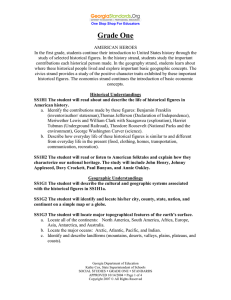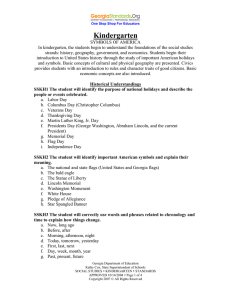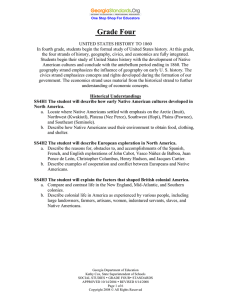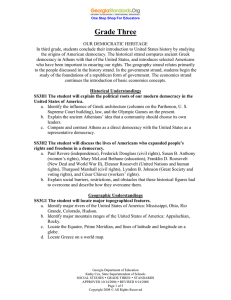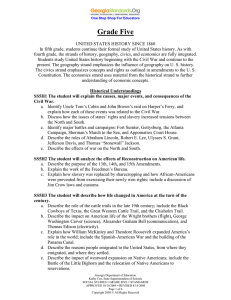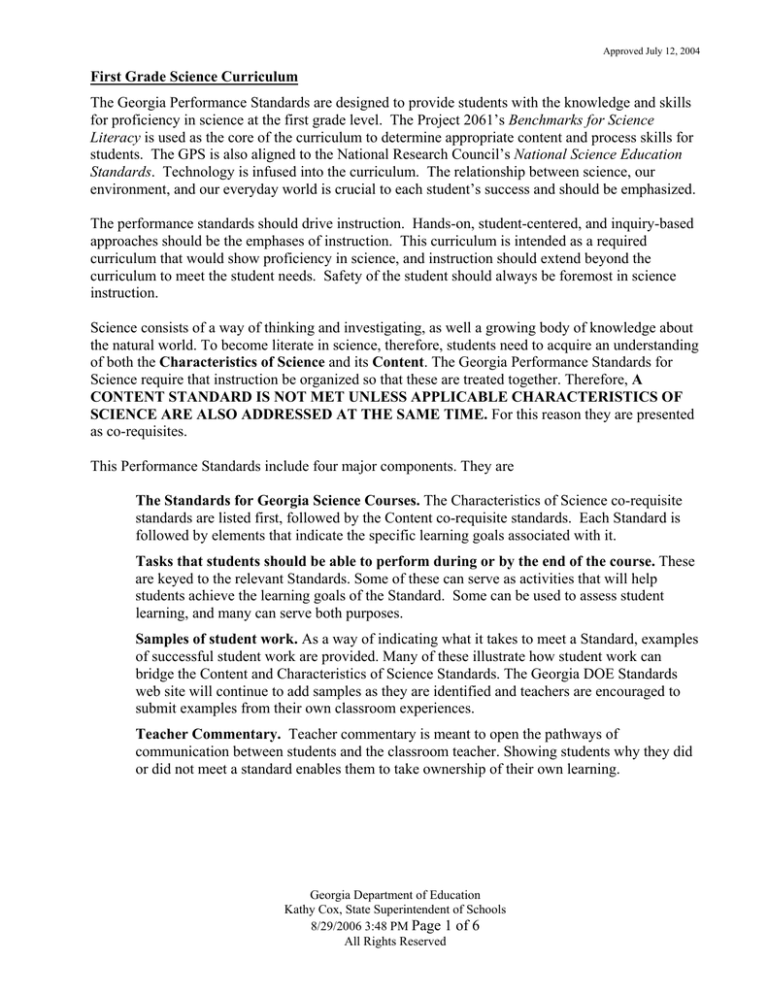
Approved July 12, 2004
First Grade Science Curriculum
The Georgia Performance Standards are designed to provide students with the knowledge and skills
for proficiency in science at the first grade level. The Project 2061’s Benchmarks for Science
Literacy is used as the core of the curriculum to determine appropriate content and process skills for
students. The GPS is also aligned to the National Research Council’s National Science Education
Standards. Technology is infused into the curriculum. The relationship between science, our
environment, and our everyday world is crucial to each student’s success and should be emphasized.
The performance standards should drive instruction. Hands-on, student-centered, and inquiry-based
approaches should be the emphases of instruction. This curriculum is intended as a required
curriculum that would show proficiency in science, and instruction should extend beyond the
curriculum to meet the student needs. Safety of the student should always be foremost in science
instruction.
Science consists of a way of thinking and investigating, as well a growing body of knowledge about
the natural world. To become literate in science, therefore, students need to acquire an understanding
of both the Characteristics of Science and its Content. The Georgia Performance Standards for
Science require that instruction be organized so that these are treated together. Therefore, A
CONTENT STANDARD IS NOT MET UNLESS APPLICABLE CHARACTERISTICS OF
SCIENCE ARE ALSO ADDRESSED AT THE SAME TIME. For this reason they are presented
as co-requisites.
This Performance Standards include four major components. They are
The Standards for Georgia Science Courses. The Characteristics of Science co-requisite
standards are listed first, followed by the Content co-requisite standards. Each Standard is
followed by elements that indicate the specific learning goals associated with it.
Tasks that students should be able to perform during or by the end of the course. These
are keyed to the relevant Standards. Some of these can serve as activities that will help
students achieve the learning goals of the Standard. Some can be used to assess student
learning, and many can serve both purposes.
Samples of student work. As a way of indicating what it takes to meet a Standard, examples
of successful student work are provided. Many of these illustrate how student work can
bridge the Content and Characteristics of Science Standards. The Georgia DOE Standards
web site will continue to add samples as they are identified and teachers are encouraged to
submit examples from their own classroom experiences.
Teacher Commentary. Teacher commentary is meant to open the pathways of
communication between students and the classroom teacher. Showing students why they did
or did not meet a standard enables them to take ownership of their own learning.
Georgia Department of Education
Kathy Cox, State Superintendent of Schools
8/29/2006 3:48 PM Page 1 of 6
All Rights Reserved
Approved July 12, 2004
Georgia Performance Science Standards-- Explanation of Coding
Characteristics of Science Standards
SKCS1
Science Kindergarten Characteristics of Science Standard #1
S8CS2
Science Grade 8 Characteristics of Science Standard #2
SCSh8
Science Characteristics of Science high school Standard #8
Content Standards
S5P3
Science Grade 5 Physical Science Standard #3
S4E2
Science Grade 4 Earth Science Standard #2
S7L4
Science Grade 7 Life Science Standard #4
SC1
Science Chemistry Standard #1
SB4
Science Biology Standard #4
SPS6
Science Physical Science Standard #6
SP3
Science Physics Standard #3
Georgia Department of Education
Kathy Cox, State Superintendent of Schools
8/29/2006 3:48 PM Page 2 of 6
All Rights Reserved
Approved July 12, 2004
First grade students raise questions about the world around them and seek answers by making
observations. They use whole numbers to analyze scientific data. They identify what things can do
when put together and what cannot be done when things are not put together. First graders create
drawings that correctly depict something being described. They follow safety rules.
Patterns
First grade students make observations, ask questions about, and investigate patterns. They learn
best from their own actions. Therefore, they make predictions and plan simple investigations in
order to understand the world around them. They notice repeating patterns in shadows, weather, and
daily needs of plants and animals.
Major Concepts/ Skills:
Earth Science
Weather patterns
Seasons
Physical Science
Sound
Shadows
Magnets
Life Science
Characteristics of living things
Basic needs of living things
Concepts/Skills to Maintain:
Habits of Mind
Asks questions
Uses numbers to quantify
Works in a group
Uses tools to measure and view
Looks at how parts of things are needed
Describes and compares using
physical attributes
Observes using senses
Draws and describes observations
Co-Requisite - Characteristics of Science
Habits of Mind
S1CS1. Students will be aware of the importance of curiosity, honesty, openness, and
skepticism in science and will exhibit these traits in their own efforts to understand
how the world works.
a. Raise questions about the world around them and be willing to seek answers to some
of the questions by making careful observations and measurements and trying to
figure things out.
S1CS2. Students will have the computation and estimation skills necessary for analyzing data
and following scientific explanations.
a. Use whole numbers in ordering, counting, identifying, measuring, and describing
things and experiences.
b. Readily give the sums and differences of single-digit numbers in ordinary, practical
contexts and judge the reasonableness of the answer.
c. Give rough estimates of numerical answers to problems before doing them formally.
d. Make quantitative estimates of familiar lengths, weights, and time intervals, and
check them by measuring.
Georgia Department of Education
Kathy Cox, State Superintendent of Schools
8/29/2006 3:48 PM Page 3 of 6
All Rights Reserved
Approved July 12, 2004
S1CS3. Students will use tools and instruments for observing, measuring, and manipulating
objects in scientific activities.
a. Use ordinary hand tools and instruments to construct, measure, and look at objects.
b. Make something that can actually be used to perform a task, using paper, cardboard,
wood, plastic, metal, or existing objects.
c. Identify and practice accepted safety procedures in manipulating science materials
and equipment.
S1CS4. Students will use the ideas of system, model, change, and scale in exploring scientific
and technological matters.
a. Use a model—such as a toy or a picture—to describe a feature of the primary thing.
b. Describe changes in the size, weight, color, or movement of things, and note which of
their other qualities remain the same during a specific change.
c. Compare very different sizes, weights, ages (baby/adult), and speeds (fast/slow) of
both human made and natural things.
S1CS5. Students will communicate scientific ideas and activities clearly.
a. Describe and compare things in terms of number, shape, texture, size, weight, color,
and motion.
b. Draw pictures (grade level appropriate) that correctly portray features of the thing
being described.
c. Use simple pictographs and bar graphs to communicate data.
The Nature of Science
S1CS6. Students will be familiar with the character of scientific knowledge and how it is
achieved.
Students will recognize that:
a. When a science investigation is done the way it was done before, we expect to get a
similar result.
b. Science involves collecting data and testing hypotheses
c. Scientists often repeat experiments multiple times, and subject their ideas to criticism
by other scientists who may disagree with them and do further tests.
d. All different kinds of people can be and are scientists.
S1CS7. Students will understand important features of the process of scientific inquiry.
Students will apply the following to inquiry learning practices:
a. Scientists use a common language with precise definitions of terms to make it easier
to communicate their observations to each other.
b. In doing science, it is often helpful to work as a team. All team members should
reach individual conclusions and share their understandings with other members of
the team in order to develop a consensus.
Georgia Department of Education
Kathy Cox, State Superintendent of Schools
8/29/2006 3:48 PM Page 4 of 6
All Rights Reserved
Approved July 12, 2004
c. Tools such as thermometers, rulers and balances often give more information about
things than can be obtained by just observing things without help.
d. Much can be learned about plants and animals by observing them closely, but care
must be taken to know the needs of living things and how to provide for them.
Advantage can be taken of classroom pets.
Co-Requisite - Content
Earth Science
S1E1. Students will observe, measure, and communicate weather data to see patterns in
weather and climate.
a. Identify different types of weather and the characteristics of each type.
b. Investigate weather by observing, measuring with simple weather instruments
(thermometer, wind vane, rain gauge), and recording weather data (temperature,
precipitation, sky conditions, and weather events) in a periodic journal or on a
calendar seasonally.
c. Correlate weather data (temperature, precipitation, sky conditions, and weather
events) to seasonal changes.
S1E2. Students will observe and record changes in water as it relates to weather.
a. Recognize changes in water when it freezes (ice) and when it melts (water).
b. Identify forms of precipitation such as rain, snow, sleet, and hailstones as either solid
(ice) or liquid (water).
c. Determine that the weight of water before freezing, after freezing, and after melting
stays the same.
d. Determine that water in an open container disappears into the air over time, but water
in a closed container does not.
Physical Science
S1P1. Students will investigate light and sound.
a. Recognize sources of light.
b. Explain how shadows are made.
c. Investigate how vibrations produce sound.
d. Differentiate between various sounds in terms of (pitch) high or low and (volume)
loud or soft.
e. Identify emergency sounds and sounds that help us stay safe.
S1P2. Students will demonstrate effects of magnets on other magnets and other objects.
a. Demonstrate how magnets attract and repel.
b. Identify common objects that are attracted to a magnet.
c. Identify objects and materials (air, water, wood, paper, your hand, etc.) that do not
block magnetic force.
Georgia Department of Education
Kathy Cox, State Superintendent of Schools
8/29/2006 3:48 PM Page 5 of 6
All Rights Reserved
Approved July 12, 2004
Life Science
S1L1. Students will investigate the characteristics and basic needs of plants and animals.
a. Identify the basic needs of a plant.
1. Air
2. Water
3. Light
4. Nutrients
b. Identify the basic needs of an animal.
1. Air
2. Water
3. Food
4. Shelter
c. Identify the parts of a plant—root, stem, leaf, and flower.
d. Compare and describe various animals—appearance, motion, growth, basic needs.
Georgia Department of Education
Kathy Cox, State Superintendent of Schools
8/29/2006 3:48 PM Page 6 of 6
All Rights Reserved
One Stop Shop For Educators
Grade One
AMERICAN HEROES
In the first grade, students continue their introduction to United States history through the
study of selected historical figures. In the history strand, students study the important
contributions each historical person made. In the geography strand, students learn about
where these historical people lived and explore important basic geographic concepts. The
civics strand provides a study of the positive character traits exhibited by these important
historical figures. The economics strand continues the introduction of basic economic
concepts.
Historical Understandings
SS1H1 The student will read about and describe the life of historical figures in
American history.
a. Identify the contributions made by these figures: Benjamin Franklin
(inventor/author/ statesman),Thomas Jefferson (Declaration of Independence),
Meriwether Lewis and William Clark with Sacagawea (exploration), Harriet
Tubman (Underground Railroad), Theodore Roosevelt (National Parks and the
environment), George Washington Carver (science).
b. Describe how everyday life of these historical figures is similar to and different
from everyday life in the present (food, clothing, homes, transportation,
communication, recreation).
SS1H2 The student will read or listen to American folktales and explain how they
characterize our national heritage. The study will include John Henry, Johnny
Appleseed, Davy Crockett, Paul Bunyan, and Annie Oakley.
Geographic Understandings
SS1G1 The student will describe the cultural and geographic systems associated
with the historical figures in SS1H1a.
SS1G2 The student will identify and locate his/her city, county, state, nation, and
continent on a simple map or a globe.
SS1G3 The student will locate major topographical features of the earth’s surface.
a. Locate all of the continents: North America, South America, Africa, Europe,
Asia, Antarctica, and Australia.
b. Locate the major oceans: Arctic, Atlantic, Pacific, and Indian.
c. Identify and describe landforms (mountains, deserts, valleys, plains, plateaus, and
coasts).
Georgia Department of Education
Kathy Cox, State Superintendent of Schools
SOCIAL STUDIES GRADE ONE STANDARDS
APPROVED 10/14/2004 Page 1 of 4
Copyright 2007 © All Rights Reserved
One Stop Shop For Educators
Government/Civic Understandings
SS1CG1 The student will describe how the historical figures in SS1H1a display
positive character traits of fairness, respect for others, respect for the environment,
conservation, courage, equality, tolerance, perseverance, and commitment.
SS1CG2 The student will explain the meaning of the patriotic words to America
(My Country ‘Tis of Thee) and America the Beautiful.
Economic Understandings
SS1E1 The student will identify goods that people make and services that people
provide for each other.
SS1E2 The student will explain that people have to make choices about goods and
services because of scarcity.
SS1E3 The student will describe how people are both producers and consumers.
SS1E4 The student will describe the costs and benefits of personal spending and
saving choices
Georgia Department of Education
Kathy Cox, State Superintendent of Schools
SOCIAL STUDIES GRADE ONE STANDARDS
APPROVED 10/14/2004 Page 2 of 4
Copyright 2007 © All Rights Reserved
One Stop Shop For Educators
Social Studies Skills Matrices
MAP AND GLOBE SKILLS
GOAL: The student will use maps to retrieve social studies information.
I: indicates when a skill is introduced in the standards and elements as part of the content
D: indicates grade levels where the teacher must develop that skill using the appropriate content
M: indicates grade level by which student should achieve mastery, the ability to use the skill in all
situations
A: indicates grade levels where students will continue to apply and improve mastered skills
Map and Globe Skills
K 1
1. use cardinal directions
I
2. use intermediate directions
3. use a letter/number grid system to
determine location
4. compare and contrast the categories of
natural, cultural, and political features
found on maps
5. use inch to inch map scale to determine
distance on map
6. use map key/legend to acquire
information from, historical, physical,
political, resource, product and economic
maps
7. use a map to explain impact of
geography on historical and current events
8. draw conclusions and make
generalizations based on information from
maps
9. use latitude and longitude to determine
location
10. use graphic scales to determine
distances on a map
11. compare maps of the same place at
different points in time and from different
perspectives to determine changes,
identify trends, and generalize about
human activities
12. compare maps with data sets (charts,
tables, graphs) and /or readings to draw
conclusions and make generalizations
3
4
5
6
M A
A
A
A
A A
A A
M A
A
A
A A
A A
I
M A
A
A A
A A
I
M A
A
A A
A A
I
M A
A
A A
A A
I
D
M A
A A
A A
I
D
M A
A A
A A
I
M A
A A
A A
I
D
D
D M A A
I
M A A
A A
I
M A A
A A
I
M A A
A A
I
Georgia Department of Education
Kathy Cox, State Superintendent of Schools
SOCIAL STUDIES GRADE ONE STANDARDS
APPROVED 10/14/2004 Page 3 of 4
Copyright 2007 © All Rights Reserved
7
8
912
2
One Stop Shop For Educators
INFORMATION PROCESSING SKILLS
GOAL: The student will be able to locate, analyze, and synthesize information related to
social studies topics and apply this information to solve problems/make decisions.
I: indicates when a skill is introduced in the standards and elements as part of the content
D: indicates grade levels where the teacher must develop that skill using the appropriate content
M: indicates grade level by which student should achieve mastery, the ability to use
the skill in all situations
A: indicates grade levels where students will continue to apply and improve mastered skills
Georgia Department of Education
Kathy Cox, State Superintendent of Schools
SOCIAL STUDIES GRADE ONE STANDARDS
APPROVED 10/14/2004 Page 4 of 4
Copyright 2007 © All Rights Reserved
One Stop Shop For Educators
Georgia Performance Standards Framework for Physical Education
FIRST GRADE
PE1.1: Demonstrates competency in motor skills and movement patterns needed to perform a
variety of activities.
Description: Students perform locomotor skills in combination with non-locomotor skills and
demonstrate mature form in the hop, jump, and leap. When traveling through general and
personal space, students demonstrate the ability to move in a variety of pathways, in different
directions, and at different levels. Several non-locomotor skills are done in a sequence or in
conjunction with locomotor or manipulative skills. Students are able to direct manipulative
objects toward an intended target.
Elements:
a. Demonstrates basic movement patterns while changing directions and levels
in general and personal space.
Examples:
Maintains balance while moving first backwards and then forwards after a cue
from the teacher.
Changes levels to maneuver through an obstacle course.
b. Demonstrates the hop, jump, and leap while participating in physical
activities.
Examples:
Uses a mature form of hopping, leaping, and jumping during rhythmic
activities.
Travels between stations by hopping, leaping, and jumping.
c. Demonstrates non locomotor skills.
Examples:
Moves while curling, twisting, and swaying.
Shows balance while performing a scale during an educational gymnastics
activity.
d. Demonstrates basic manipulative skills.
Examples:
Kicks a stationary ball.
Strikes a balloon using various body parts.
Georgia Department of Education
Kathy Cox, State Superintendent of Schools
December 11, 2008 * Page 1 of 6
All Rights Reserved
One Stop Shop For Educators
Georgia Performance Standards Framework for Physical Education
FIRST GRADE
PE1.2: Demonstrates understanding of movement concepts, principals, strategies, and tactics as
they apply to the learning and performance of physical activities.
Description: Students use movements and manipulative skill concepts while expanding and
applying skills to their basic knowledge.
Elements:
a. Demonstrates knowledge of basic locomotor skills.
Examples:
Students skip through general space on cue.
Students will change locomotor skills on verbal command.
b. Demonstrates knowledge of basic non-locomotor skills.
Examples:
Students curl, twist, or bend when prompted.
Students design a combination of non-locomotor skills.
c. Demonstrates use of movement concepts while striking and kicking.
Examples:
Students use appropriate force to kick a stationary ball to the wall or to a
partner.
Students strike the balloon with different degrees of force to move the balloon
to different levels.
Georgia Department of Education
Kathy Cox, State Superintendent of Schools
December 11, 2008 * Page 2 of 6
All Rights Reserved
One Stop Shop For Educators
Georgia Performance Standards Framework for Physical Education
FIRST GRADE
PE1.3: Participates regularly in physical activity.
Description: Students express pleasure when participating in physical activity. Students begin to
utilize the skills and knowledge acquired in physical education class during their leisure time
physical activity and while learning new activities outside physical education classes.
Elements:
a. Improves skills while participating in enjoyable activities.
Examples:
Improves tossing and catching skills when playing catch with a partner.
Improves rhythmic skills with Lummi Sticks.
b. Participates in physical activity most days of the week.
Examples:
Participates in school clubs or programs featuring physical activities.
Rides bikes after school.
c. Participates regularly in a variety of non-structured and minimally
organized physical activities inside and outside of physical education class.
Examples:
Plays tag games at recess or hop scotch.
Plays jump rope games.
Georgia Department of Education
Kathy Cox, State Superintendent of Schools
December 11, 2008 * Page 3 of 6
All Rights Reserved
One Stop Shop For Educators
Georgia Performance Standards Framework for Physical Education
FIRST GRADE
PE1.4: Achieves and maintains a health enhancing level of physical fitness.
Description: Students will enjoy physical activity for short periods of time. They can identify
basic physiological signs associated with participation in moderate to vigorous physical activity.
Elements:
a. Participates in fitness and conditioning related activities.
Examples:
Participates in moderate to vigorous activity continuously for at least 5
minutes.
Traverses along a rock wall with little teacher assistance.
b. Identifies physiological indicators that accompany moderate to vigorous
physical activities.
Examples:
After playing crab soccer, students are able to identify breathing hard as an
example of physical exertion.
Recognizes that doing push-ups makes your arm muscles tired.
Recognizes that stomach muscles get tired when doing sit-ups or crunches.
Identifies that the heart beats faster after dancing or moving vigorously.
Georgia Department of Education
Kathy Cox, State Superintendent of Schools
December 11, 2008 * Page 4 of 6
All Rights Reserved
One Stop Shop For Educators
Georgia Performance Standards Framework for Physical Education
FIRST GRADE
PE1.5: Exhibits responsible personal and social behavior that respects self and others in physical
activity settings.
Description: Students recognize rules, directions, and safety procedures while participating in
physical activity. Their ability to work cooperatively and respectfully with others, regardless of
personal differences, begins to be a self-initiated process.
Elements:
a. Demonstrates self-control and follows rules and procedures with very little
teacher direction.
Examples:
Lines up at the end of class in the appropriate spot.
Keeps hands and body under control.
b. Uses body, space, and equipment safely.
Examples:
Moves safely in a large group while changing directions and pathways.
Swings pillo-polo stick while remaining in a safe space.
c. Cooperates with others.
Examples:
Uses kindness and encouragement to help others.
Takes turns throwing at a target.
d. Uses appropriate means to resolve simple conflicts on their own.
Examples:
Allows a partner to have a “redo”.
Apologizes for stepping on someone’s hand.
Georgia Department of Education
Kathy Cox, State Superintendent of Schools
December 11, 2008 * Page 5 of 6
All Rights Reserved
One Stop Shop For Educators
Georgia Performance Standards Framework for Physical Education
FIRST GRADE
PE1.6: Values physical activity for health, enjoyment, challenge, self- expression, and/or social
interaction.
Description: Students will identify personal enjoyment in physical activity and can describe
their favorite activities. Students find pleasure in the experience of meeting challenges and
learning new skills.
Elements:
a. Participates in and describes enjoyment of various physical activities.
Examples:
Identifies physical activity preferences.
Completes teacher created survey to show emotions experienced during
activity.
b. Willingly participates in new and challenging activities.
Examples:
Is excited at the prospect of learning a new game.
Challenges self at stations to improve the skill needed for a new
activity.
Georgia Department of Education
Kathy Cox, State Superintendent of Schools
December 11, 2008 * Page 6 of 6
All Rights Reserved

